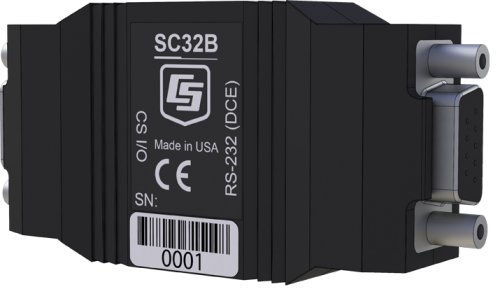
Overview
The SC32B Optically Isolated Interface is used to connect the CS I/O port on a datalogger with the RS-232 port on a PC. This interface converts the RS-232 voltage levels of the computer to the CMOS levels of the datalogger. It also isolates the electrical system of the computer from the datalogger, thereby protecting against ground loop, normal static discharge, and noise.
Read MoreBenefits and Features
- Connects a PC to the CS I/O port of a data logger
- Helps protect components from electrical damage
- No power source needed—powered by data logger and PC
- Ships with cables needed for most uses
- Baud rates up to 115 kbps supported
Images






Technical Description
The SC32B, or another interface, is required for direct communications between a PC and a CR510, CR10X, or CR7 datalogger. For our CR800, CR850, CR1000, and CR1000X dataloggers, the SC32B is often used to provide optical isolation between the data logger and PC. Although the on-board RS-232 port of the CR3000, CR5000, or CR9000X dataloggers is isolated, the SC32B can be interfaced with their CS I/O port when a second RS-232 port is required in the application.
The SC32B is shipped with an SC12 (2 ft) cable for attachment to the data logger and a 10873 (6 ft) cable for attachment to the PC. Alternatively, an SC12R-6 (6 ft) cable (purchased separately) can be used instead of the standard SC12 when a longer cable is needed.
The SC32B can support RS-232 cable lengths of up to 50 feet; longer cable lengths are not recommended. The longer cable should be on the data logger side of the interface (CMOS logic levels) as opposed to the RS-232 side, which is typically more sensitive to drops in signal voltage levels.
Compatibility
Please note: The following shows notable compatibility information. It is not a comprehensive list of all compatible products.
Dataloggers
| Product | Compatible | Note |
|---|---|---|
| CR9000 (retired) | The CR9000 requires a CR9080 PAM module. |
Additional Compatibility Information
Data Logger Considerations
The SC325B is compatible with data loggers that have a CS I/O port.
Specifications
| Baud Rates Supported | Up to 115 kbps |
| Power | Drawn from the serial ports of the PC and data logger |
| Typical Current Drain |
|
| Connections | 9-pin RS-232 socket (female) port configured as DCE; 9-pin pin (male) port |
| Operating Temperature Range | -25° to +50°C |
| Dimensions | 4.1 x 2.3 x 7.6 cm (1.6 x 0.9 x 3.0 in.) |
| Weight | 45.4 g (1.6 oz) |
Related Documents
Product Brochures
Compliance
Related FAQs
Number of FAQs related to SC32B: 10
Expand AllCollapse All
-
No. The SC32B cannot be used at the same time as an SDC device. The SC32B is a modem-enabled device and is not capable of concurrent communication.
-
Because the SC-USB includes a processor, it costs more to manufacture than the SC32B.
-
Yes. It ships with both the SC12 and 10873 serial cables. Usually, the SC12 is connected to the datalogger, and the 10873 is connected to the computer.
-
No, because it would not work. The SC32B is used to do the following:
- Convert datalogger logic levels (on the CS I/O port) to RS-232 levels
- Optically isolate the datalogger from the RS-232 peripheral
-
Communication through the datalogger’s CS I/O port requires an interface that converts the computer’s RS-232 voltage levels to the CMOS levels of the datalogger. Typically, that interface is an SC32B. The SC32B connects to the datalogger’s CS I/O port via an SC12 or serial cable and connects to a computer’s 9-pin serial port via a serial cable. When the computer does not have a serial port, a 9-pin serial-to-USB cable, such as pn 17394, can be used with the SC32B. Alternatively, instead of the SC32B, use the SC-USB.
-
Non-isolated interfaces (that is, connection to the RS-232 port with a standard serial cable connection) can cause ground offset errors in analog measurements using a system connected to a PC and powered by an ac source. The SC32B provides isolation that may be important when recording low-level, single-ended voltage measurements.
-
There are several options:
- Use the SC-USB connector/interface instead of the SC32B.
- Use the SC32B with a pn 17394, USB-to-9-Pin Male RS-232 Cable.
- Use a user-supplied USB interface with the SC32B.
If the datalogger being used has an RS-232 port, only a serial cable is needed. It is not necessary to use the SC32B unless there is another device connected to the RS-232 port or there are concerns about low-level noise from a permanently connected, ac-powered computer.
-
The SC32B is not needed for a datalogger that has an RS-232 port. If the RS-232 port is not being used by another peripheral, the port can be used with a serial cable or a serial-to-USB cable to connect to the computer.
-
This is not necessarily an error associated with the SC32B. The message means that an attempt to check or set the clock on a mixed-array datalogger (CR10, CR21X, CR7X, CR10X, CR510, and CR23X) failed. There could be several reasons for this error.

